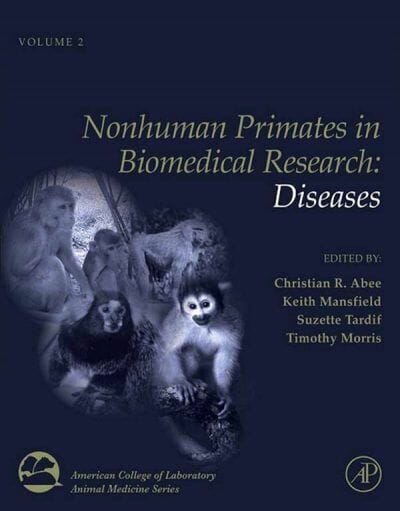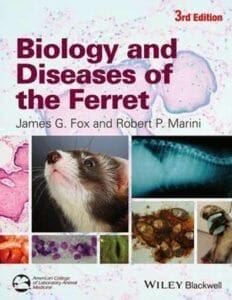Chapter 1. Viral Diseases of Nonhuman Primates
Introduction
Enveloped DNA Viruses
Nonenveloped DNA-Containing Viruses
Enveloped RNA-Containing Viruses
Nonenveloped RNA-Containing Viruses
Chapter 2. Bacterial and Mycotic Diseases of Nonhuman Primates
Introduction
Bacterial Diseases
Mycotic Diseases
Chapter 3. Tuberculosis Research using Nonhuman Primates
Introduction
Human Tuberculosis
Pathobiology of Human Disease: Natural History of Tuberculosis
Primate Models of Tuberculosis
Pathological Features of Model
Statistical Considerations
Occupational Health and Safety Considerations: Biosafety Level 3 Pathogen
Specific Areas of Research that Benefit from the Nonhuman Primate Model of Tuberculosis
Alternative Animal Models, In Silico Models, and In Vitro Systems
Summary
Acknowledgments
Chapter 4. Parasitic Diseases of Nonhuman Primates
Introduction
Protozoan Parasites
Metazoan Parasites
Acknowledgments
Chapter 5. Nonhuman Primate Models for Human Malaria Research
Introduction
Human Malaria
Life Cycle of Primate Malaria Parasites
Clinical Malaria and Pathology
Nonhuman Primate Models of Human Malaria (Biology, Disease Pathogenesis, Immunity, and Testing of Vaccines or Drugs)
Some Methods and Considerations for Investigations of Malaria Biology and Vaccines
Chapter 6. Neoplasia and Proliferative Disorders of Nonhuman Primates
Introduction
Characterization of Neoplasia
Mechanisms of Cancer Development
System Specific Neoplasia
Treatment and Prognosis
Chapter 7. Hematopoietic, Cardiovascular, Lymphoid and Mononuclear Phagocyte Systems of Nonhuman Primates
Introduction
Hematology
The Heart and Vasculature
Lymphoid and Mononuclear Phagocyte Systems
Chapter 8. Nonhuman Primate Models of Atherosclerosis
Introduction
Pathobiology of Human Atherosclerosis
Advantages of a Nonhuman Primate Model
Introduction to Primate Models
New World Monkeys
Old World Monkeys
Summary Assessment
Acknowledgements
Chapter 9. Respiratory System Diseases of Nonhuman Primates
Introduction
Respiratory System Structure and Function
Approach to the Patient with Respiratory Disease
Upper Airway Diseases
Lower Respiratory Tract Diseases
Disorders of the Diaphragm, Pleura, and Mediastinum
Viral Diseases
Bacterial Diseases and Agents
Mycotic Diseases
Protozoan Diseases
Metazoan Parasites
Acknowledgment
Chapter 10. Urogenital System
Part A. Urinary System
Urinary System
Part B. Genital System: Female
Genital System: Female
Part C. Genital System: Male
Genital System: Male
Chapter 11. Integumentary System Diseases of Nonhuman Primates
Introduction
Structure and Function of the Skin
Definitions and Descriptions of Skin Lesions
Examination of the Skin
Diseases of the Skin
Chapter 12. Digestive System Diseases of Nonhuman Primates
Introduction
Oral Cavity
Stomach and Intestine
Liver
Exocrine Pancreas
Acknowledgments
Chapter 13. Arthritis, Muscle, Adipose Tissue, and Bone Diseases of Nonhuman Primates
Introduction
Arthritis
Connective Tissue Disorders
Skeletal Muscle Diseases
Adipose Tissue Disorders
Bone Diseases
Nutritional Disorders
Musculoskeletal Neoplasia
Acknowledgments
Chapter 14. Diabetes and Obesity Research using Nonhuman Primates
Review of Diabetes in Humans
Review of Diabetes in Nonhuman Primates
Methods for Evaluating Diabetes in Nonhuman Primates
Nonhuman Primate Models of Diabetes
Pathologic Changes in Islets in Diabetic Monkeys
Co-Morbid Conditions in Diabetes
Sex Hormones and Effects on Insulin Resistance and Diabetes
Effects of Stress, Diet, and Caloric Restriction on Insulin Resistance and Diabetes
Pharmacologic Interventions to Treat Diabetes and Obesity
Conclusions and Future Directions
Acknowledgments
Chapter 15. Nervous System Disorders of Nonhuman Primates and Research Models
Clinical and Diagnostic Approaches
Specific Procedures
Naturally Occurring Infectious Diseases
Congenital and Developmental Conditions
Age-Related Changes in the CNS
Nutritional and Metabolic Disorders
Miscellaneous Conditions
Neoplasia of the Nervous System
Important Nonhuman Primate Models of Human Neurologic Diseases
Chapter 16. Nonhuman Primate Models of the Motor System
Introduction
The Rationale for Using Nonhuman Primates in Research Focused on the Motor System
Nonhuman Primate Models and Research on the Motor System
The 3RS and Nonhuman Primate Research on the Motor System
Acknowledgments
Chapter 17. Imaging in Research Using Nonhuman Primates
Introduction
Animal Preparation
Advanced Imaging Techniques
Chapter 18. Nonhuman Primate Models of Drug and Alcohol Addiction
Introduction
The Self-Administration Model
Addiction as a Disease of the Brain
Pharmacokinetic Factors Important for Addiction Research
Behavioral Similarities Important for Addiction Research
Genetic Factors Important for Addiction Research
Conclusions














![Ettinger’s Textbook of Veterinary Internal Medicine 9th Edition [PDF+Videos] Ettinger’s Textbook of Veterinary Internal Medicine 9th Edition [True PDF+Videos]](https://www.vet-ebooks.com/wp-content/uploads/2024/10/ettingers-textbook-of-veterinary-internal-medicine-9th-edition-100x70.jpg)

![Textbook of Veterinary Diagnostic Radiology 8th Edition [PDF+Videos+Quizzes] Thrall’s Textbook of Veterinary Diagnostic Radiology, 8th edition PDF](https://www.vet-ebooks.com/wp-content/uploads/2019/09/textbook-of-veterinary-diagnostic-radiology-8th-edition-100x70.jpg)






